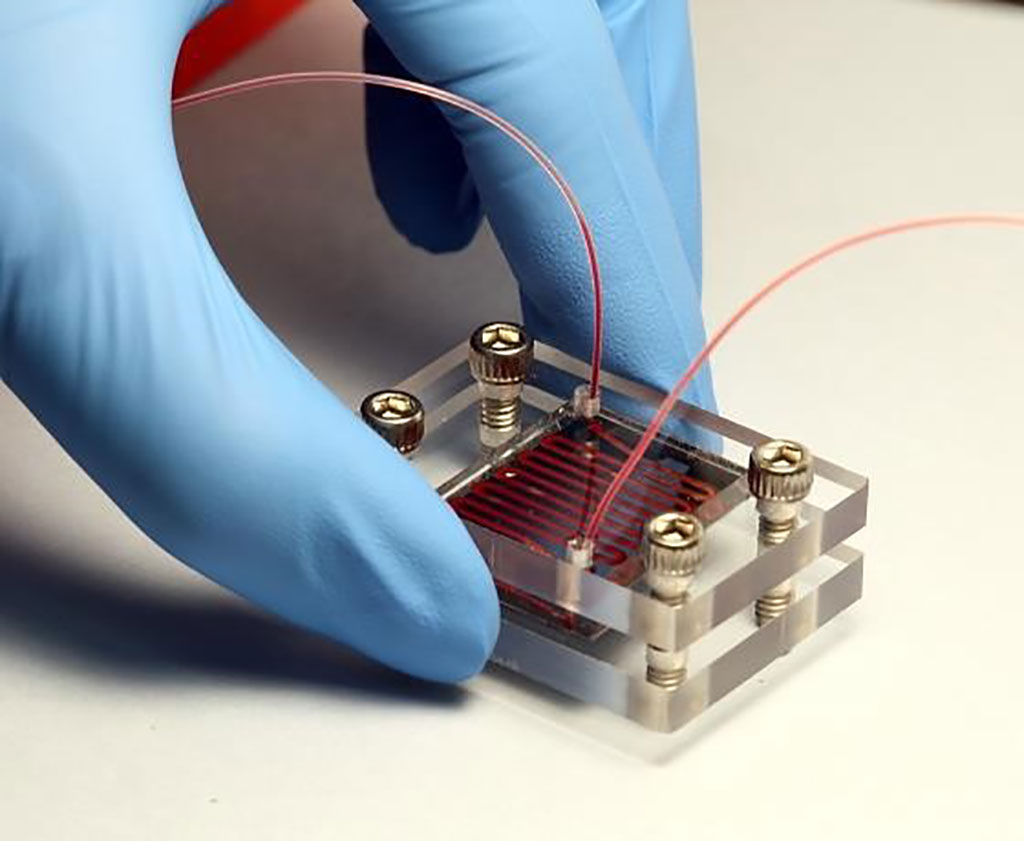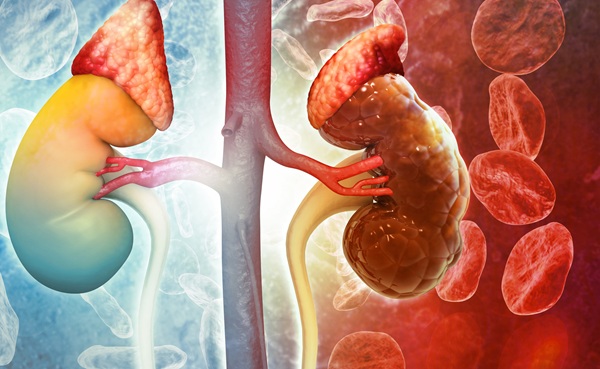NanoVelcro Cell Technology Applied in Diagnosis of Pregnancy Complications
|
By LabMedica International staff writers Posted on 02 Sep 2021 |

Image: The NanoVelcro device has been used to detect placenta accreta spectrum (PAS) disorders (Photo courtesy of University of California, Los Angeles)
Placenta accreta spectrum (PAS) disorders, including placenta accreta, placenta increta, and placenta percreta, are the consequences of abnormal implantation, or aberrant invasion and adherence of placental trophoblasts into the uterine myometrium.
Current diagnostic modalities for PAS, including serum analytes, ultrasonography, and magnetic resonance imaging (MRI), are effective but not always conclusive, and some options are not readily available in low resource settings. Circulating trophoblast cell clusters can be used for early detection of PAS disorders.
Medical Scientists at the University of California, Los Angeles (UCLA, Los Angeles, CA, USA) and their colleagues included in a study pregnant women aged from 18 to 45 years old with singleton intrauterine pregnancies, and gestational age (GA) between 6 and 40 weeks. The team analyzed blood samples from 168 pregnant individuals, divided between those with clinically confirmed PAS, placenta previa, or normal placentation and an additional 15 healthy non-pregnant female donors served as controls.
The investigators used the a cell isolation technology called NanoVelcro Chip developed by UCLA. NanoVelcro is a nanostructure-embedded microchip designed to capture and enrich specific target cells from a mixed sample. The samples were run through NanoVelcro Chips under optimized conditions and immunostained and were imaged using the Nikon Ni fluorescence microscope (Melville, NY, USA). Trophoblast-specific gene expression in placenta tissue was performed to validate the selected trophoblast-specific gene panel.
The team discovered a uniquely high prevalence of clustered circulating trophoblasts (cTB-clusters) in PAS and subsequently optimized the device to preserve the intactness of these clusters. The feasibility study on the enumeration of cTBs and cTB-clusters from 168 pregnant women demonstrates excellent diagnostic performance for distinguishing PAS from non-PAS. The combined cTB assay achieves an Area Under ROC Curve of 0.942 (throughout gestation) and 0.924 (early gestation) for distinguishing PAS from non-PAS. Overall, single cTBs are detected in the majority of pregnant women, with a detection rate of 98%, 85%, and 86% in the groups of PAS, placenta previa, and normal placentation, respectively.
Margareta D. Pisarska, MD, an Obstetrics and Gynecology Endocrinologist and co-author of the study, said, “In maternal health and delivery, we think of having a child and having a delivery as, overall a happy, healthy event. But in situations like this, these are very difficult times to try to manage through. And if we have a plan in place, schedule the delivery, have the right members on the team on board, have all the things prepared that should lead to a more scheduled controlled delivery.”
The authors concluded that the combination of cTBs and cTB-clusters captured on the NanoVelcro Chips for detecting PAS early in gestation will enable a promising quantitative assay to serve as a noninvasive test and also as a complement to ultrasonography to improve diagnostic accuracy for PAS early in gestation. The study was published on August 3, 2021 in the journal Nature Communications.
Related Links:
Nikon
University of California, Los Angeles
Current diagnostic modalities for PAS, including serum analytes, ultrasonography, and magnetic resonance imaging (MRI), are effective but not always conclusive, and some options are not readily available in low resource settings. Circulating trophoblast cell clusters can be used for early detection of PAS disorders.
Medical Scientists at the University of California, Los Angeles (UCLA, Los Angeles, CA, USA) and their colleagues included in a study pregnant women aged from 18 to 45 years old with singleton intrauterine pregnancies, and gestational age (GA) between 6 and 40 weeks. The team analyzed blood samples from 168 pregnant individuals, divided between those with clinically confirmed PAS, placenta previa, or normal placentation and an additional 15 healthy non-pregnant female donors served as controls.
The investigators used the a cell isolation technology called NanoVelcro Chip developed by UCLA. NanoVelcro is a nanostructure-embedded microchip designed to capture and enrich specific target cells from a mixed sample. The samples were run through NanoVelcro Chips under optimized conditions and immunostained and were imaged using the Nikon Ni fluorescence microscope (Melville, NY, USA). Trophoblast-specific gene expression in placenta tissue was performed to validate the selected trophoblast-specific gene panel.
The team discovered a uniquely high prevalence of clustered circulating trophoblasts (cTB-clusters) in PAS and subsequently optimized the device to preserve the intactness of these clusters. The feasibility study on the enumeration of cTBs and cTB-clusters from 168 pregnant women demonstrates excellent diagnostic performance for distinguishing PAS from non-PAS. The combined cTB assay achieves an Area Under ROC Curve of 0.942 (throughout gestation) and 0.924 (early gestation) for distinguishing PAS from non-PAS. Overall, single cTBs are detected in the majority of pregnant women, with a detection rate of 98%, 85%, and 86% in the groups of PAS, placenta previa, and normal placentation, respectively.
Margareta D. Pisarska, MD, an Obstetrics and Gynecology Endocrinologist and co-author of the study, said, “In maternal health and delivery, we think of having a child and having a delivery as, overall a happy, healthy event. But in situations like this, these are very difficult times to try to manage through. And if we have a plan in place, schedule the delivery, have the right members on the team on board, have all the things prepared that should lead to a more scheduled controlled delivery.”
The authors concluded that the combination of cTBs and cTB-clusters captured on the NanoVelcro Chips for detecting PAS early in gestation will enable a promising quantitative assay to serve as a noninvasive test and also as a complement to ultrasonography to improve diagnostic accuracy for PAS early in gestation. The study was published on August 3, 2021 in the journal Nature Communications.
Related Links:
Nikon
University of California, Los Angeles
Latest Technology News
- Machine Learning Models Diagnose ALS Earlier Through Blood Biomarkers
- Artificial Intelligence Model Could Accelerate Rare Disease Diagnosis
- AI Saliva Sensor Enables Early Detection of Head and Neck Cancer
- AI-Powered Biosensor Technology to Enable Breath Test for Lung Cancer Detection
- AI Model Achieves Breakthrough Accuracy in Ovarian Cancer Detection
- Portable Biosensor Diagnoses Psychiatric Disorders Using Saliva Samples
- Cell-Sorting Device Uses Electromagnetic Levitation to Precisely Direct Cell Movement

- Embedded GPU Platform Enables Rapid Blood Profiling for POC Diagnostics
- Viral Biosensor Test Simultaneously Detects Hepatitis and HIV
- Acoustofluidic Device to Transform Point-Of-Care sEV-Based Diagnostics
- AI Algorithm Assesses Progressive Decline in Kidney Function
Channels
Clinical Chemistry
view channel
POC Breath Diagnostic System to Detect Pneumonia-Causing Pathogens
Pseudomonas aeruginosa is a major cause of hospital-acquired and ventilator-associated pneumonia, particularly in lung transplant recipients and patients with structural lung disease. Its ability to form... Read more
Online Tool Detects Drug Exposure Directly from Patient Samples
Doctors often rely on patient interviews and medical records to determine what medications a person has taken, but this information is frequently incomplete. People may forget drugs they used, take over-the-counter... Read moreMolecular Diagnostics
view channel
Blood Biomarker Improves Early Brain Injury Prognosis After Cardiac Arrest
After a cardiac arrest, many patients remain unconscious for days, leaving doctors and families facing uncertainty about whether meaningful recovery is possible. Current tools to assess brain damage, including... Read more
Biomarkers Could Identify Patients at High Risk of Severe AKI After Major Surgery
Acute kidney injury is one of the most common and dangerous complications after major surgery, particularly among patients in intensive care. Even mild impairment of kidney function can lead to long-term... Read more
CLIA Test Identifies Head and Neck Cancer Recurrence from Post-Surgical Lymphatic Fluid
While the lymphatic system’s critical role in metastasis has long been recognized, routine access to patient lymph has been elusive. Now, a non-invasive process can access lymph through the collection... Read moreHematology
view channel
MRD Tests Could Predict Survival in Leukemia Patients
Acute myeloid leukemia is an aggressive blood cancer that disrupts normal blood cell production and often relapses even after intensive treatment. Clinicians currently lack early, reliable markers to predict... Read more
Platelet Activity Blood Test in Middle Age Could Identify Early Alzheimer’s Risk
Early detection of Alzheimer’s disease remains one of the biggest unmet needs in neurology, particularly because the biological changes underlying the disorder begin decades before memory symptoms appear.... Read more
Microvesicles Measurement Could Detect Vascular Injury in Sickle Cell Disease Patients
Assessing disease severity in sickle cell disease (SCD) remains challenging, especially when trying to predict hemolysis, vascular injury, and risk of complications such as vaso-occlusive crises.... Read more
ADLM’s New Coagulation Testing Guidance to Improve Care for Patients on Blood Thinners
Direct oral anticoagulants (DOACs) are one of the most common types of blood thinners. Patients take them to prevent a host of complications that could arise from blood clotting, including stroke, deep... Read moreImmunology
view channelBlood Test Could Detect Adverse Immunotherapy Effects
Immune checkpoint inhibitors have transformed cancer treatment, but they can also trigger serious immune-related adverse events that damage healthy organs and may become life-threatening if not detected early.... Read more
Routine Blood Test Can Predict Who Benefits Most from CAR T-Cell Therapy
CAR T-cell therapy has transformed treatment for patients with relapsed or treatment-resistant non-Hodgkin lymphoma, but many patients eventually relapse despite an initial response. Clinicians currently... Read moreMicrobiology
view channel
Blood-Based Diagnostic Method Could Identify Pediatric LRTIs
Lower-respiratory tract infections (LRTIs) are a leading cause of illness and death worldwide, and pneumonia is the leading infectious cause of death in children under five, claiming the lives of over... Read more
Rapid Diagnostic Test Matches Gold Standard for Sepsis Detection
Sepsis kills 11 million people worldwide every year and generates massive healthcare costs. In the USA and Europe alone, sepsis accounts for USD 100 billion in annual hospitalization expenses.... Read moreRapid POC Tuberculosis Test Provides Results Within 15 Minutes
Tuberculosis remains one of the world’s deadliest infectious diseases, and reducing new cases depends on identifying individuals with latent infection before it progresses. Current diagnostic tools often... Read more
Rapid Assay Identifies Bloodstream Infection Pathogens Directly from Patient Samples
Bloodstream infections in sepsis progress quickly and demand rapid, precise diagnosis. Current blood-culture methods often take one to five days to identify the pathogen, leaving clinicians to treat blindly... Read moreTechnology
view channel
Machine Learning Models Diagnose ALS Earlier Through Blood Biomarkers
Amyotrophic lateral sclerosis (ALS) is a rapidly progressive neurodegenerative disease that is notoriously difficult to diagnose in its early stages. Early symptoms often overlap with other neurological... Read more
Artificial Intelligence Model Could Accelerate Rare Disease Diagnosis
Identifying which genetic variants actually cause disease remains one of the biggest challenges in genomic medicine. Each person carries tens of thousands of DNA changes, yet only a few meaningfully alter... Read moreIndustry
view channel
BD and Penn Institute Collaborate to Advance Immunotherapy through Flow Cytometry
BD (Becton, Dickinson and Company, Franklin Lakes, NJ, USA) has entered into a strategic collaboration with the Institute for Immunology and Immune Health (I3H, Philadelphia, PA, USA) at the University... Read more




















